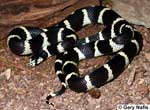The common kingsnake (Lampropeltis getula) is distributed throughout North America, ranging from Oregon to Mexico in the western portion of the continent and from New Jersey to the Florida panhandle in the eastern portion of the continent (Krysko, 2002). There are several subspecies of L. getula, which differ in geographic location and appearance. These include L. g. californiae from California, L. g. nigrita and L. g. splendida from northern Mexico and the southwest United States, L. g. holbrooki from Colorado, L. g. nigra from the eastern United States (Bartlett and Tennant, 2000), L. g. floridana from Florida (Krysko, 2002), and L. g. getula ranging from New Jersey to Florida (Krysko and Judd, 2006).
(Lampropeltis getula) is distributed throughout North America, ranging from Oregon to Mexico in the western portion of the continent and from New Jersey to the Florida panhandle in the eastern portion of the continent (Krysko, 2002). There are several subspecies of L. getula, which differ in geographic location and appearance. These include L. g. californiae from California, L. g. nigrita and L. g. splendida from northern Mexico and the southwest United States, L. g. holbrooki from Colorado, L. g. nigra from the eastern United States (Bartlett and Tennant, 2000), L. g. floridana from Florida (Krysko, 2002), and L. g. getula ranging from New Jersey to Florida (Krysko and Judd, 2006).
The common kingsnake is a member of Colubrinae. Colubrinae is a diverse grouping of snakes that includes more than 150 genera and 700 species. Colubrines are cosmopolitan except for Australia and live in a variety of habitats, although no species are classified as marine or true burrowers. Colubrines vary greatly in size; the smallest is less than 20cm in length, and the largest is over three meters in length (Pough et al., 2004).
The common kingsnake varies from 76cm to two meters in length. Eastern subspecies are typically longer than western subspecies. Their diet includes turtle eggs, young turtles, snakes (including venomous species), lizards, frogs, salamanders, bird eggs, and small mammals. The species is not poisonous and uses constriction to kill its prey (Bartlett and Tennant, 2000). Although prey suffocate under the pressure of constriction, some authors have suggested that constriction also induces circulatory and cardiac arrest in mammalian species (Moon, 2000). The common kingsnake is capable of eating other snakes that exceed its own body length through bending the vertebral column of its prey into waves (Jackson et al., 2004)!
Reproduction in the common kingsnake is oviparous. Females lay at least one clutch every year. Clutches average between two and 24 eggs with an incubation period of 45-60 days (Bartlett and Tennant, 2000). The common kingsnake is a seasonal breeder with the mating season occurring between March and June (Krysko, 2002).
Additional Information on the Skull
Click on the thumbnails below for labeled images of the skull in standard anatomical views.

About the Species
This specimen was collected from Payne's Prairie, 12 miles southwest of Gainesville, Florida by A. B. Grobman and M. B. Mittleman on 2 April 1941. It was made available to The University of Texas High-Resolution X-ray CT Facility for scanning by Dr. Jessie Maisano of The University of Texas at Austin and Mr. Alan Resetar of the Field Museum. Funding for scanning and image processing was provided by a National Science Foundation Assembling the Tree of Life grant (EF-0334961), The Deep Scaly Project: Resolving Squamate Phylogeny using Genomic and Morphological Approaches, to Drs. Jacques Gauthier of Yale University, Maureen Kearney of the Field Museum, Jessie Maisano of The University of Texas at Austin, Tod Reeder of San Diego State University, Olivier Rieppel of the Field Museum, Jack Sites of Brigham Young University, and John Wiens of SUNY Stonybrook.

Lateral view of the scanned specimen.

About this Specimen
The specimen was scanned by Matthew Colbert on 6 July 2004 along the coronal axis for a total of 675 slices. Each 1024x1024 pixel slice is 0.063 mm thick, with an interslice spacing of 0.063 mm and a field of reconstruction of 26.5 mm.

About the
Scan
Literature
Bartlett, R. D., and A. Tennant. 2000. Snakes of North America. Gulf Publishing Co., Houston, TX. 312 pp.
Jackson, K., N. J. Kley, and E. L. Brainerd. 2004. How snakes eat snakes: the biomechanical challenegs of ophiophagy for the California kingsnake, Lampropeltis getula californiae (Serpentes: Colubridae). Zoology 107:191-200.
Krysko, K. L., and W. S. Judd. 2006. Morphological systematics of kingsnakes, Lampropeltis getula complex (Serpentes: Colubridae), in the eastern United States. Zootaxa 1193:1-39.
Krysko, K. L. 2002. Seasonal activity of the Florida kingsnake Lampropeltis getula floridana (Serpentes: Colubridae) in southern Florida. American Midland Naturalist 148:102-114.
Moon, B. R. 2000. The mechanics and muscular control of constriction in gopher snakes (Pituophis melanoleucus) and a king snake (Lampropeltis getula). Journal of Zoology 252:83-98.
Links
Lampropeltis getula on the Herps of Texas website (University of Texas at Austin)
Lampropeltis getula on the Animal Diversity Web (University of Michigan)

Literature
& Links
Three-dimensional volumetric renderings of the skull with the hyoid and jaw removed, and of the isolated left mandible. All are less than 2mb.

Additional
Imagery
















